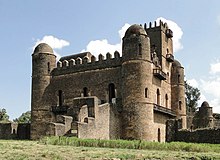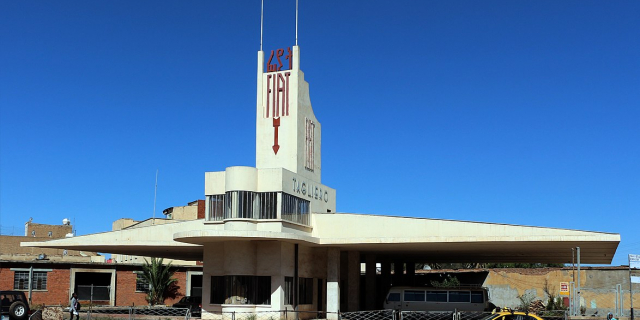Gondar
Gondar, also spelled Gonder (Amharic: ጎንደር, Gonder or Gondär; formerly ጐንደር, Gʷandar or Gʷender), is a city and woreda in Ethiopia. Located in the North Gondar Zone of the Amhara Region, Gondar is north of Lake Tana on the Lesser Angereb River and southwest of the Simien Mountains. As of 2023, Gondar has an estimated population of 487,224.
Gondar previously served as the capital of both the Ethiopian Empire and the subsequent Begemder Province. The city holds the remains of several royal castles, including those in the Fasil Ghebbi UNESCO World Heritage Site for which Gondar has been called the "Camelot of Africa".
 Fasilides Castle, founded by Emperor Fasilides
Fasilides Castle, founded by Emperor FasilidesGondar was originally a small market town inhabited by Muslim traders and Beta Israel craftsmen. In 1635 Emperor Fasilides selected Gondar as his camp, certainly for the purpose of directly supervising the collection of customs on the Red Sea - Tana - Ennarya trade routes. This was the same reason that induced his immediate predecessors, beginning with Emperor Sarsa Dengel in the 1570s, located their capitals on Lake Tana's northeastern flank, along with a concern for safety in view of Oromo conquests in the central highlands. Situated about 35 km due north of the lake in the midst of Kémant country, Gondar was on, or close to, the point at which the main caravan track from Metemma to Tana joined the route from Ennarya to the Red Sea. Other advantages were a semi-circle of mountains that afforded protection, nearby fertile agricultural lands and a permanent water supply. Popular legends, how-ever, maintain that Fasilides was led to the site by prophecy and miraculous events.
Within the capital, Fasilides ordered the construction of the imposing edifice known as the Fasil Ghebbi or Fasilides Castle. Further, he established five other churches, including Mädòane Aläm and Fit Abbo (the latter close to the church of Arbaétu Ensésa, one of the four local churches that predate Gondar's founding). The pleasure-pool with stone pavilion beside the Qaha river known as the "Bath of Fasilides" and several bridges are also commonly attributed to him. In 1648, a Yemeni ambassador sent by Al-Mutawakkil Isma'il who visited the palace described it as a great house of stone and lime and "one of marvelous of buildings, worthy of admiration, and the most beautiful of outstanding wonders. The head stone mason was an Indian named Abdal Kerim who had previously worked on the palace of Emperor Susenyos I in Danqaz. In the newly built castle Al-Haymi saw beds from Istanbul, mattresses from India glittering with gold, sofas inlaid with pieces of jewelry and gems. His eye was also struck by the attire of the courtiers: gowns of silk brocade embroidered with gold, silk gowns, golden girdles "set with marvelous stones and precious gems", swords from Sennar inlaid with the choicest pure gold. Seeing this wealth, al-Haymi, thought of the prescriptions of Islamic Law according to which men are forbidden to wear gold and silver ornaments, silk garments, and to use silk for beds and chairs.[1] According to the Royal Chronicles, the edifices of Yohannes I and Iyasu I where reported to have been built by a man named Walda Giyorgis, who was "endowed with intelligence". The latter use of an Ethiopian architect rather than a foreign one suggests that by then the foreign community in Gondar had largely been expelled[2]
In 1668, as a result of a church council, the Emperor Yohannes I ruled that the inhabitants of Gondar were to be segregated by religion. This caused the Muslims and Jews to move into their own quarters within two years. The decree, reissued in 1676, meant that almost all Muslims in Gondar subsequently resided in the lower part of the town beside the Qaha, a quarter known as Eslam Bet or Eslamge. The Beta Israel were assigned four quarters, two of them, Abarra and Kayla Meda, beside the Qaha. Aside from the royal enclosure, known as the Makkabäbiya or Fail Gémb, other significant quarters were the Addebabay, a public square on the south of the royal compound, a place of assemblies and the Monday market; Abun Bet, north-west of the castles, residence of the abun, or Metropolitan, and a place of asylum; Eccäge Bet, west of the castles, residence of the -éccäge and also a refuge for offenders; Qañn Bet, east-south-east of the castles and home to many nobles; and Déngay, further south-west and inhabited by Christian merchants. To the far south-south-east lay the main (Saturday) market and beyond it, Eslamge at the foot of the Gondar's plateau. By the reign of Iyasu the Great, the city's population is estimated to have exceeded 60,000. Many of the buildings from this period survive, despite the turmoil of the eighteenth century. [3]
18th centuryAs Gondar expanded, successive emperors built new palaces, churches, and monuments. Empress Mentewab built her own palace near the vicinity of Fasilides' royal compound, and also constructed a church near her residence, adorned by beautiful paintings and illuminated manuscripts. Fires, such as the one in 1732 during the defeat of a rebel force loyal to Iyasu II, provided excuses for emperors to engage in construction. The city's growth, fueled by trade conducted in weekly markets south of the castle complex, also influenced demographics. Ecclesiastical suburbs emerged, including the Muslim Islambet or Islamge, the Jewish community of Falasha Bet involved in blacksmithing and pottery, and Echege Bet and Abuna Bet, both centers for the Ethiopian Church. Poetry and music became preeminent, as the city would become renowned for its secular songs, several Gondarine poets achieved nation wide reputation.
 17th century library and chancellery in Gondar
17th century library and chancellery in GondarThe Oromo influence in Gondar rapidly began to increase in the 18th century. The last Gondarine Emperor to exercise full control was Iyasu II, during his reign multiple revolts broke out and it became apparent that the country was on the eve of political change. He was succeeded by Iyoas I, who effectively became an Oromo puppet. The city was now guarded by 3,000 Oromo troops and had essentially been taken over by the Oromos. In the face of overwhelming opposition towards the Oromo newcomers, Iyoas was forced to appeal to the powerful warlord Mikael Sehul. Ras Mikael thus became master of Gondar, and later had Iyoas deposed and murdered. The Empire thus entered a period of supreme difficulty when its authority declined during the Zemene Mesafint.[4]
19th centuryGondar's fortunes declined further as the locus of the kingdom shifted south-east to Shewa. After the mid-1850s, no more emperors reigned in Gondar, Emperor Tewodros II refused to live there and he suspected its population of disloyalty. In early 1864, he sought to compel Muslims to convert to Christianity, a decree that fell heavily upon Gondar's numerous Muslims, most of whom complied, if only nominally. Later that year, Tewodros sent his soldiers to sack the city. Confronted with further opposition, Tewodros and his army plundered and burned Gondar in December 1866. Most churches were looted and destroyed and their treasures - gold and silver crosses, nearly 1,000 manuscripts - were carted off to Debre Tabor, Tewodros's capital, that he intended to become the "new Gondar"[5][6]
In January 1888 and again in June 1889, the Sudanese Dervishes (Mahdists) burned what was left of Gondar, even the Muslim inhabitants weren’t spared. By the early 20th century, the population had dwindled to a few thousand. Muslims still controlled the caravan trade, which was confined mostly to the regional level, and some had begun to settle in the upper town close to the castles. A German traveller Felix Rosen labelled Gondar "a dead city that belongs wholly to the past".[7]
20th centuryAfter the military occupation of Ethiopia by the Kingdom of Italy in 1936, Gondar was further developed under Italian occupation.[8]: 28–37 Local inhabitants were segregated into districts west and south of the castle enclosure, Italians settling in northern and north-eastern areas. New commercial and government buildings were erected north-east of the castles and a retail district, known hence-forth as the "piazza", was laid out adjacent to the castle compound, all in 1930s "modernist" architecture. A central artery linked the Italian quarters, piazza, Ethiopian merchant quarter, and Saturday market. Another new road ran west of the Fasil "bath" and on to Azezo, where a landing-strip provided an air service with Asmara. Other new roads connected the city with Gojjam and with Eritrea, the latter a paved, all-season roadway. Colonial authorities, seeking to curry favour with local Muslims, built a mosque (for the first time with minaret) beside the Saturday market, authorized the appointment of a gadi for matters involving the Sara and permitted Muslims to settle outside Addis Alem.
During the Second World War, Mussolini's Italian forces made their last stand in Gondar in November 1941, after Addis Ababa fell to British forces six months before. The area of Gondar was one of the main centers of activity of Italian guerrilla against the British forces until summer 1943.[8]: 55–60
During the Ethiopian Civil War, the forces of the Ethiopian Democratic Union (EDU) gained control of large parts of Begemder, and around 1977 the EDU operated within a few kilometers of Gondar, and appeared to be at the point of capturing the city.[9] As part of Operation Tewodros near the end of the Civil War, Gondar was captured by the Ethiopian People's Revolutionary Democratic Front in March 1991.[10]


























Add new comment